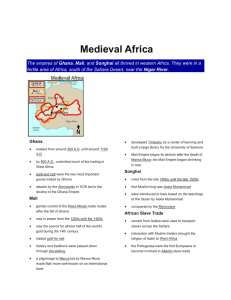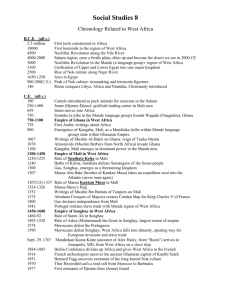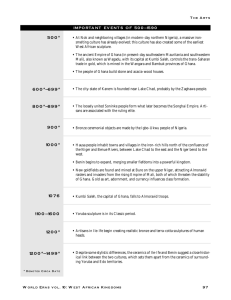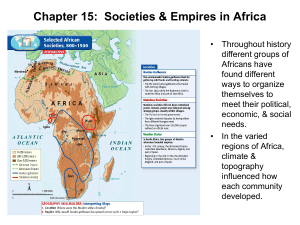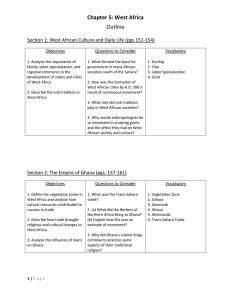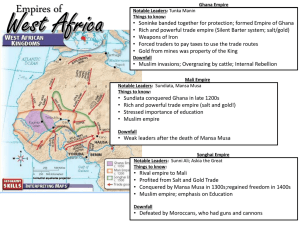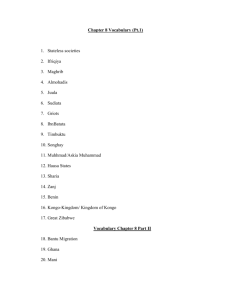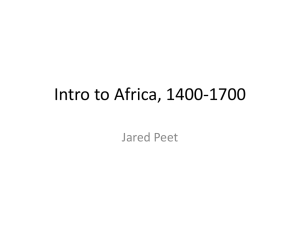AFRICAN-AMERICAN STUDIES
advertisement
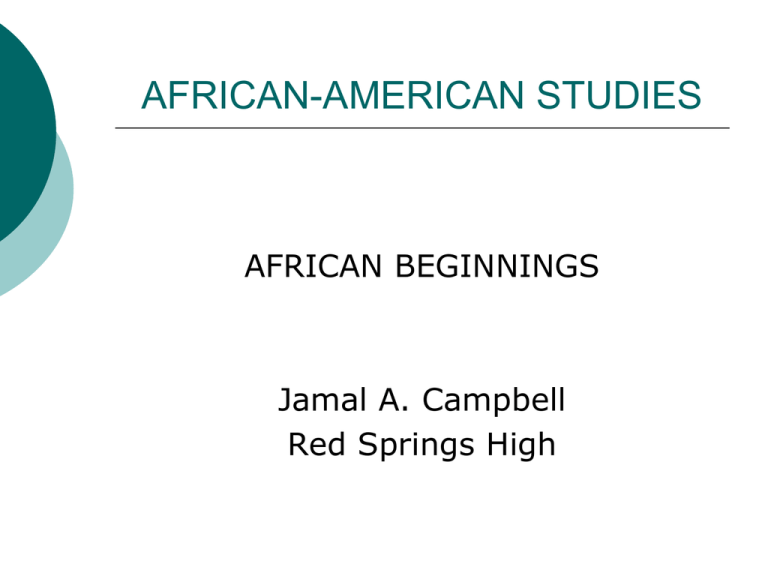
AFRICAN-AMERICAN STUDIES AFRICAN BEGINNINGS Jamal A. Campbell Red Springs High FOCUS When you think of Africa, what images come to your mind? How is Africa and the people portrayed in the media? Who is a African? BACKGROUND Africa is the second largest continent Pop 700 million people The continent is sparsely populatedtwo-thirds of the people live in the tropics Africa has three major deserts: the Kalahari (South), Namib (South), and Sahara (North). In the West, Central and Southwest regions contains dense sprawling rain forests. They are often incorrectly referred to as jungles. Lakes and rivers are central to African life as sources of livelihood, commerce, and basic transportation. Africa’s major rivers are: The Nile (at over four thousand miles, it’s the world’s longest river) in the Northeast Zambezi (Southeast) The Congo (Southwest) Niger, Benue, and Senegal (West) Word Africa used by ancient Romans to refer to their colonial province in the area. Its possible derivations are the Latin word aprica—meaning “sunny” and the Greek word aphrike—meaning “without cold” Early Humans Archeological finds suggest that Africa is the cradle of humankind. Earliest fossil remains of humans were found in eastern and southern Africa. Examples of human remains discovered 1. Bipedality (“walking upright”) human remains found in Ethiopia in 1974 of a 4 million year old apelike creature 2. Homo habilus (tool makers) remains found in 1986 in Tanzania of a 2 million year old human that made tools from stones that were sharpen or flattened—tools made from ribs of large mammals had pointed blades used as spears 3. “Fire makers” also homo erectus found in Kenya of a one-million year old human 4. Homo sapiens “thinking/talking man” or modern man human found in East Africa which dates back 100,000 years ago Two Theories of Human Migration All evidence points to human life starting in Africa and from there humans migrated to the rest of the world. Anthropologists and paleontologists have come up with two theories of human migration from Africa which are: 1) the “out of Africa” theory 2) the “multiregional” theory Out of Africa” Theory Research shows that the maternal ancestry of every person today is traceable to an “African Eve” (dates back 100,000 to 200,000 yrs ago) “ The earliest modern humans (homo sapiens) begin to migrate out of Africa moving into the Middle East and southern Europe and by about 60,000 yrs ago into the rest of the world. As different groups entered different climatic conditions, racial differences gradually developed. (Important to note people at this time were classified by their culture not race) This theory is supported by molecular biologist (whose job is tracing genetic lineage)---their research shows more genes coming from African ancestry and that Africans have been diversifying longer and represent the earliest modern branch of the family tree “Multiregional” Theory This this argues modern humans (homo sapiens) did not solely emerge in Africa but arose independently in different places in Africa, Europe, and Asia. It also suggest migration out of Africa occurred 1 to 2 million years ago with the homo erectus—moving out of Africa and colonizing much of the world From the homo erectus according to the “multiregionalists” regional groups emerged—racial divergences occurred 1 million yrs ago Racial groups evolved for a long time in isolation and possibly at different times (moving from homo erectus to homo sapiens) Fossil findings in Israel of a modern looking homo sapiens which dates back about 92,000 yrs ago supports this theory Early Egypt Africa’s early history is marked by the emergence of agriculturalists in the north In the fourth millennium B.C., after hunting had been abandoned in favor of farming, Lower and Upper Egypt were united. The Upper Nile’s King Menes, the 1st pharaoh and 1st to start a dynasty, achieved this unification between 3400 and 3200 B.C. The history of Egypt is divided up into three time periods Old Kingdom, Middle Kingdom, and New Kingdom. Pyramids During the third and fourth dynasties the great pyramids were constructed as royal burial chambers. The first was designed and built by Imhotep, adviser to the pharaoh Zoser. (Imhotep is also recognized as being a physician who was the 1st to write about embalming, mummification, and the human circulatory system). The pyramid was built about 2650 B.C. in Lower Egypt It is the oldest standing building in the world The pyramids on the Giza Plateau near Cairo. At far right is the Great Pyramid of Khufu (Cheops), in the middle and closer is the pyramid of Khafre, and on left is the smallest of the three major Giza pyramids - that of Menkaure. Three small subsidiary pyramids are at the extreme left The economic cost to building the pyramids weakened the nation thus driving it into civil wars thereby allowing outsiders to conqueror Egypt. Three Great Empires 1. 2. 3. With political and economic stability set in Africa, three great empires emerged Ghana Mali Songhay Ghana (300-1076) 1st great empire to emerge, comprised of the northern subgroup of the Mandingo During the 10th century the Ghana empire reached its height and also gained full control of the southern section of the western transSaharan trade route Ghana would be conquered by desert Berbers in 1076 Ghana would later regain their independence but would be conquered again in 1203 In 1240 the Ghana empire would become part of the Mali empire Mali (1050-1488) The Mali empire emerged from a unification of a number Mandingo tribes Sundiata was the founder of the Mali empire, with his defeat of the Ghana empire in 1240 it led to his take over of other territories in Africa Sundiata was given the title of Mansa or emperor By 1255, the Mali empire controlled majority of the trading towns in Africa (salt, gold, copper mines) Mansa Musa will rule the Mali empire between 1312-1337 During his reign he advanced the economy of the empire, he was known across the region due to the economic reforms he started Sankore became the most famous of the Mali cities, a Muslim university was established there, it possessed collections of Greek, Roman, and Arabic writings By the 14th century the Mali empire started to fall apart. As the empire disintegrated their rich trading posts were attacked and taken over by neighboring groups The Mali empire ended with the rise of new Sudanic states which would usher in the last great empire of Africa Songhay (1355-1591) By the 15th century the Songhay people broke free of Mali domination and begin to expand its frontier by taking the Mali territories Sunni Ali led this expansion, he brought most of the Sudan trading centers under Songhay rule After the death of Sunni Ali, Askia Muhammad would take over. He was a devout Muslim Muhammad increase the spread of Islam in the area, he was established a Islamic law code. He personally trained the judges how to interpret the law Askia Muhammad wanted to increase Muslim influence in academics, begin to grant land to Muslims who were a part of the special class of scholars so that the area would be known as the Islamic learning center. Despite all his achievements, Askia Muhammad sons got rid of him in 1528. From 1528-1591, the empire suffered from a lack of leadership due to assassinations, civil wars, and an absence of a fixed law of succession. Due to these factors the Songhay empire collapsed in 1591 when the Moroccans from the north invaded and conquerored them. The Moroccans used their new weapons (guns and cannons) to beat the Songhay people. Important to note, the fall of Songhay takes place 100 years after Christopher Columbus’s first voyage to the New World Religion Islam was initially introduced into the Western Sudan by nomadic Muslim groups (for example, Berbers) and traders (Berber, Arab, and native) who worked the internal routes of the Western Sudan. The adoption of Islam enabled wandering traders in particular to find hospitality, as well as a sense of community, among fellow Muslim traders in communities along the trade routes. As these traders moved farther into the interior, they carried Islam with them, stimulating a process of Islamization that ultimately involved the conversion of some chiefs and political rulers. The spread of Islamic influence and ideas extended beyond purely religious matters. For example, although administration in the Western Sudan evolved from indigenous systems of government, Islam played a part in the development of better administrative practices. Muslim scholars, jurists, and administrators brought with them the most modern ideas of government from the Muslim world; they acted as interpreters, scribes, and treasurers to most of the rulers of the Western Sudanic empires, Additionally, what we know of these empires comes from contemporary accounts furnished mainly by Muslim sources.
